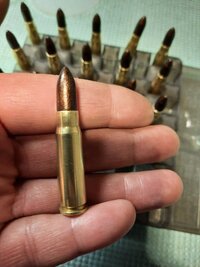What's the source of your acetone?Played around some more.
Mixed results. Could be too cold out there even with the heater on.
How old is it?
Do you wet rags directly from the container (put the rag on the opening and tilt to soak the rag)?
If you enjoy the forum please consider supporting it by signing up for a NES Membership The benefits pay for the membership many times over.
Be sure to enter the NES/MFS May Giveaway ***Canik METE SFX***
What's the source of your acetone?Played around some more.
Mixed results. Could be too cold out there even with the heater on.
those lee real cast with pure?View attachment 731241
I had to pour a few yesterday for the in-line and I may load up a few 8mm with IMR4198 to see if I can get some results close to @Artie. Anything that gets me to the range I guess.
yeah casting as soft as possible really helps.They were casted with mostly stick on wheel weight so they are not exactly pure. But they load really nice in the online. Far easier then the Hornady sabots. I have to swab every couple rounds with the sabots… these keep on loading up no prob with plenty of lube.
More or less under 1500 fps you should be good with no gas checkWhat’s the alloy needed for no gas check?
Thanks. I knew there was an upper limit but he pushed 1700 fps with no gas check.More or less under 1500 fps you should be good with no gas check
1500+ need a gas check
I gas check all but the slow gallery type loads
I personally would not push a gas check designed bullet much more than 1200 fps.Thanks. I knew there was an upper limit but he pushed 1700 fps with no gas check.
I just kind of figured to make it easy that rifle would need a gas check but not so much for pistol.
Maybe that’s why it went all wobbly when he exceeded 1525. Not so much due to the powder changes affected actual accuracy
Probably not enough to see any down range performance.I found some time yesterday to load up some more 14 grains x39 and a few 38 spl with True Blue and True Blue looks like it will meter really good in the Dillon. I was ringing steel at the 100 till the plate fell off and that was good enough for my purposes for now. I’m going to give the gun a good cleaning to see what the barrel looks like and possibly slug it again and measure with a micrometer. I don’t know if I used dial calipers when I measured the first time and came up with .324. @pastera gave me a great lesson on slugging and measuring with micrometer at the casting class the other year so I’ll do it again.
@mac1911 thanks for the detailed explanation because it makes sense and I want to keep poking and playing to come up with the best combos. 2400 is what I have a few pounds of but I do have a limited supply IMR-4895 if that can be used as an alternative.
Another question I wanted to throw out there is how much variance in the weight of the bullet will have on the overall accuracy. I know its a big factor if I was going to bench rest precision rifle shooting over a large distance. Yesterday I was loading up the test rounds for the 38SPL with True Blue with bullets the kid casted and he landed a large percentage right at 158.8 mark with the Lee 158 FP mold where some of my .312 155 grain varied from 158 to 162gr and some of that was due to diff alloys and my technique. I didn’t know if there is a standard like if they are all within X percent of the total weight you shouldn’t see any major variance in performance. I know there are variables that come into play but this is one that could be controlled.
Gordons Reloading ToolProbably not enough to see any down range performance.
Your rifle/skills are a larger variable than a few grains on the bullet.
If it helps just sort your bullets.
I will sort sometimes.
Target weight plus minus .2 grains then under and over
Play around with a ballistics calculator.
I've found it is pretty accurate for powders with "green" calibration dataI just downloaded the Gordon tool to play with later….
![Machine Gun [mg] [mg]](/xen/styles/default/xenforo/smilies.vb/036.gif)

I had great results with True Blue in 45ACP, 7.4gr behind a 215gr SWC. Meters well in my cheap Lee powder measure.Good luck…. I had some good luck with True Blue in 38SPL today and I’ll post up some results.
Oooooooo nice job!
